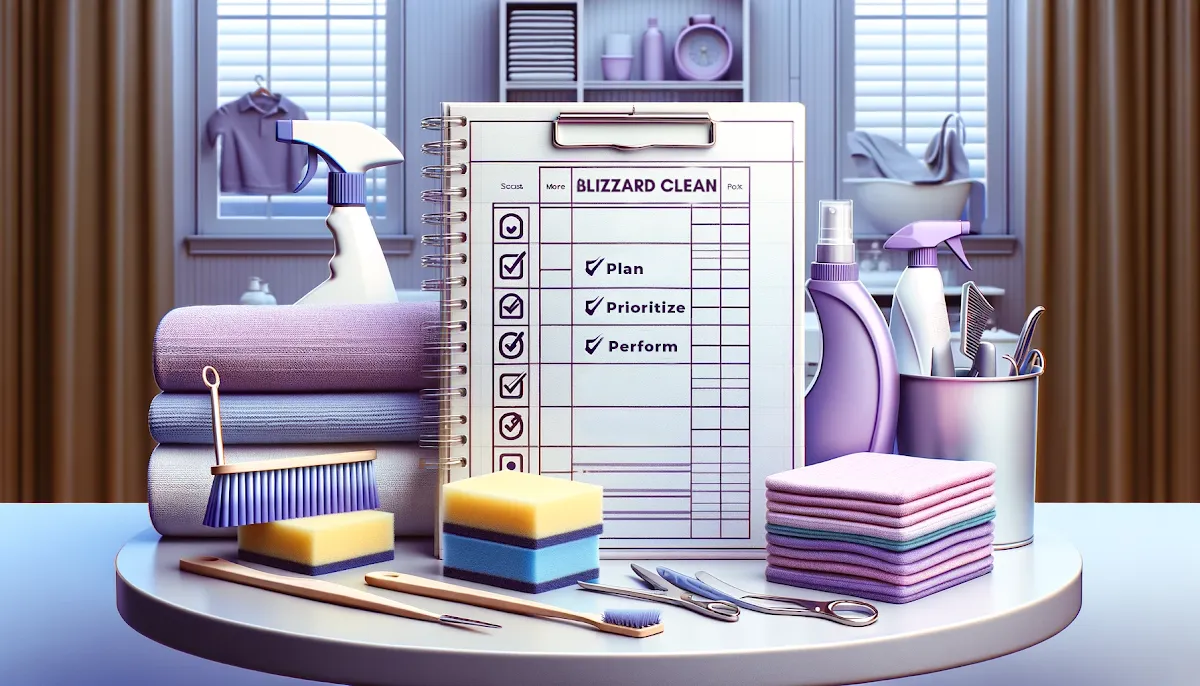Keeping a spotless home isn’t just about making a good impression; it’s a fundamental part of a healthy lifestyle. A well-planned cleaning schedule can transform how you view housekeeping while bolstering mental and physical health. This article is your guide to creating an effective weekly cleaning routine using the 3 of Cleaning – Plan, Prioritize, and Perform.
Need help dusting those ceiling fans consistently? Do you struggle with remembering when the bathroom needs a deep clean? Or your carpet rarely experiences the warm hum of a vacuum. Rolling up your sleeves and ready to mop a sparkling clean home is much easier when you have a clear cleaning schedule.
Interestingly, there is a link between clean homes and the health status of the residents. People who describe their living spaces as ‘cluttered’ or full of ‘unfinished projects’ are more depressed and fatigued than those with homes they describe as ‘restful’ and ‘restorative.’
So, every task on your cleaning checklist counts, whether it’s tidying up the living room or running the dishwasher. Allow this guide to show you how managing your space with a cleaning schedule is the trick you’re missing to a cleaner home and a healthier you.
The best part? You’re not dealing with the daunting task of staying on top of house cleaning alone. Using a cleaning routine, you can transform your residential cleaning experience, relieve unnecessary stress, and, most importantly, create a safer, healthier living space. Buckle up as we delve into the 3 Ps of cleaning: Plan, Prioritize, and Perform!
Plan: Creating Your Cleaning Checklist
Planning is crucial for designing a successful cleaning schedule, as the first ‘P’ of the 3 Ps suggests. A core component of this planning process involves creating a comprehensive cleaning checklist. This checklist ensures you will complete all important tasks and helps organize your cleaning routine effectively. Let’s break down the steps to create your cleaning checklist:
- Inventory Your Home: Note every room and space to be cleaned, including the kitchen, bathroom, bedroom, and living areas.
- List All Cleaning Tasks: Identify each task, from dusting furniture to vacuuming carpets, mopping floors, and scrubbing bathroom tiles.
- Break Down The Checklist: Separate the cleaning tasks into daily, weekly, and monthly cleaning tasks. For instance, tidying the living room daily, while deep cleaning carpets and ceiling fans can be scheduled monthly.
- Allocate Time: Assign a suitable amount of time for each task to help you manage your cleaning routine smoothly.
- Print The Checklist: Make your cleaning schedule tangible by printing the checklist. This will help you stay on track and easily monitor progress.
By breaking down cleaning tasks into daily, weekly, and monthly categories, you’re more likely to stick to your cleaning schedule. Not only does this help manage your time efficiently, but it also creates a sense of accomplishment as you consistently check off items on your list.

So, roll up those sleeves and make your cleaning routine more manageable by planning and creating a cleaning checklist that caters to your specific needs. Keep your checklist within reach, whether hanging on the fridge or stored electronically, to stay focused on your mission for a clean home.
Prioritize: Schedule Your Cleaning
Our second ‘P’ — Prioritize — is about developing a feasible and realistic cleaning schedule that helps you stay on top of your housework while making your home a refreshing sanctuary. This organized cleaning strategy revolves around three main elements: daily, weekly, and monthly cleaning tasks.
Daily Cleaning: Small Steps for Big Impact
Daily cleaning revolves around tackling small tasks that need to be done every day. From wiping down kitchen countertops to cleaning the bathrooms, these tasks don’t take much time and prevent the accumulation of germ-laden grime. Establishing a daily cleaning schedule is your essential daily cleaning routine to keep your home clean and tidy.
Weekly Cleaning: Maintain the Sparkle
Next is your weekly cleaning schedule. Think of this as your guide to cleaning tasks that combat mess and clutter that could creep up after a single cleaning day. This typically includes vacuuming high-traffic areas, dusting, cleaning kitchen appliances, and washing bathroom surfaces. As a quick sweep for dust and dirt or a microfiber cloth wipe for surfaces, ensuring these specific tasks in your weekly cleaning routine helps maintain the sparkle.
Monthly Cleaning: Deep Dive and Declutter
Finally, your monthly cleaning tasks dive deeper into your home cleaning schedule. From carpet cleaning to cleaning air vents, it’s a time to clean everything you might have missed or needs less frequent attention. Monthly cleaning includes washing the windows on a cloudy day, scrubbing grout, cleaning and organizing the garage, or even a mini spring cleaning to declutter your spaces.
Allocating Time and Resources Efficiently
When you prioritize your cleaning tasks appropriately and create a weekly and monthly cleaning routine, you’ll find it easier to stick to the plan. Use a weekly and monthly cleaning checklist to ensure you are on track. Whether a printable version or a digital, always have these checklists at your disposal.
Remember, there’s no better way to keep a home consistently clean than sticking to a practical house cleaning schedule. It’s not about cleaning every single corner daily. It’s about setting realistic cleaning goals, efficiently using your time and resources, and, most importantly, making it part of your routine. Stay organized and empowered as you sweep, scrub, and sanitize your way to a pristine home.
Perform: Implementing The Cleaning Schedule
The third ‘P’ — Perform — is all about action and the practical application of your cleaning schedule. A detailed checklist is excellent, but the real test comes when you implement the cleaning routine.
Initiating the Daily Cleaning Schedule: Basic Daily Cleaning to Start With
Initiating the daily cleaning schedule refers to your daily tasks to keep your home tidy. This includes dusting surfaces, vacuuming high-traffic areas, and mopping where necessary. It’s about making sure your place is pristine and inviting each day, and there’s nothing like coming home to a clean home each day.
Graduating from Daily House Cleaning to Weekly Cleaning Tasks: How to
Once you have a daily cleaning routine, it’s time to integrate the weekly cleaning tasks into your regimen. This means performing a deeper cleaning of key areas in your home: the bathroom gets a thorough scrub, carpets receive a proper vacuuming, and ceiling fans are dusted. The key is to adopt a routine that feels natural to perform, not like a house chore. It might seem challenging initially, but eventually, you’ll find a rhythm that fits your lifestyle.
Successful Execution of a Monthly Cleaning Schedule
Executing a monthly cleaning schedule is about focusing on areas that can be maintained with less frequent cleaning. This includes washing windows, maintaining appliances like your dishwasher, and deep cleaning your home. Through consistent monthly cleaning, you ensure that no corner of your house is left ignored.
Realistic Cleaning: Adaptation and Modifications of the Routine as per Your Lifestyle
The most significant part of establishing an effective cleaning schedule is to have a realistic approach. If your cleaning checklist aligns with your lifestyle, you’ll likely be able to keep up with it. Hence, recognize your limitations and be ready to adapt and modify your cleaning routine as necessary.

Implementing a cleaning schedule successfully is all about consistency. Sticking to it becomes much easier once you’ve set a routine that works for you. Remember, a clean home doesn’t just look good — it contributes to your overall well-being, allowing you to live in a space that truly feels like a restful escape.
Prioritizing Cleaning Tasks
You must learn the art of prioritizing cleaning tasks to stick to your cleaning schedule. Assigning importance to different chores and setting priorities is crucial in effectively maintaining a clean home. Let’s explore how to prioritize tasks and the advantages of doing so.
Assigning Importance to Different Tasks
Categorizing your cleaning tasks into daily, weekly, and monthly chores is the first step in assigning importance. Focus on essential daily tasks like wiping countertops, sweeping high-traffic areas, and cleaning the bathrooms. Keep your home clean by setting reachable goals every day. Next, create a weekly cleaning schedule that involves tasks like vacuuming carpets and cleaning vents. Finally, incorporate monthly cleaning tasks that dive deeper into organizing and decluttering your home.
How to Set Priorities
Analyzing your lifestyle is essential for setting priorities in your cleaning schedule. For instance, cleaning and organizing a home office might be a top priority if you work from home. Stay realistic about your needs, and allocate the right amount of time to tasks that matter to you. When you learn to prioritize, you can stick to your cleaning schedule and make your home germ-free.
For better clarity, use printable cleaning lists or a digital tool of your preference to sort tasks. Try free printables available online or a daily cleaning checklist to organize your priorities.
Advantages of Task Prioritization
By emphasizing prioritization in your cleaning schedule, you’ll notice several advantages:
- Improved focus: Assigning importance to tasks lets you concentrate on what matters the most in keeping your home clean.
- Less stress: Prioritizing prevents you from feeling overwhelmed by the amount of housework, reducing anxiety.
- Effective time management: Knowing what to clean and when helps you use your time efficiently, allowing you to stay on top of your cleaning without neglecting other responsibilities.
- Customization: Prioritizing tasks helps you design a cleaning routine that suits your lifestyle, which increases the likelihood of maintaining it.
Embracing a well-planned and prioritized cleaning schedule is your ultimate guide to a clean, organized home. You can maintain a tidy, peaceful living space with a clear understanding of daily, weekly, and monthly tasks. Stay consistent in your priorities, and enjoy the benefits of a cleaner, more inviting home.
Useful Tools And Techniques
Mastering your cleaning schedule can be a breeze with the right tools and techniques. Utilize time management and task tracking software to stay organized and streamline your daily, weekly, and monthly cleaning tasks. Let’s dive into some helpful tools and techniques to take your cleaning schedule to the next level.
Time Management and Task Tracking Software
To optimize your cleaning schedule, task tracking software can help you stay on top of daily house cleaning, weekly chores, and even monthly cleanings. Numerous apps can help you create a home cleaning schedule and provide reminders to keep you on track. Explore options that suit your needs and preferences, enabling you to stick to your cleaning routine.
Printable Cleaning Checklists
Free printables like daily and weekly cleaning checklists are ideal for those who prefer a physical list. Customize these printable resources to match your cleaning tasks and priorities, making your cleaning routine manageable and enjoyable.
The Power of Timers
A timer can be your best friend when it comes to cleaning. Set a timer for each task, allowing you to stay focused and complete chores efficiently. The timer creates a sense of urgency, helping you clean areas like kitchen countertops, baseboards, or even high-traffic areas in record time.
Cleaning Products and Equipment
Invest in high-quality cleaning products, such as microfiber cloths and scrub brushes, to make your chores easier and more effective. Remember to consider the importance of using the right equipment for specific tasks like carpet cleaning or wiping down bathroom surfaces with soapy water.
Embrace Techniques like Decluttering and Sanitizing
Managing cleaning tasks also involves embracing techniques like decluttering to tackle mess and clutter efficiently. Focus on sanitizing germ-prone areas as part of your cleaning schedule, ensuring your home is clean and healthy.
By incorporating these valuable tools and techniques into your cleaning schedule, you can create a more enjoyable and efficient routine that helps you keep your home clean. Explore the various options and customize your approach to find the perfect balance of tools and techniques for a consistent, well-maintained living space.

Helpful Tips For An Effective Cleaning Schedule
Optimizing your cleaning schedule can genuinely transform your living space. Here are some strategic tips to elevate your cleaning routine:
#1. Consider Hiring a Cleaner
After a long, grueling week, cleaning your home can seem like a colossal task. Consider hiring a professional cleaner for a deep clean. This can ensure a clean home while you catch your breath – a convenience that’s often worth the investment.
#2. Resist the Buildup of Clutter
Regular decluttering helps resist the buildup of clutter, keeping your home tidy and pleasant. Commit to a weekly cleaning schedule that includes decluttering tasks.
#3. Managing Pet Dander
Pets bring joy but also bring dander. Weekly vacuuming is vital in households with furry friends to keep dander and dust in check and ensure a clean home.
#4. Quick Sweep vs. Thorough Vacuum
When short on time, a quick sweep works. But remember, thorough vacuuming should still be a feature in your weekly cleaning to maintain clean carpets and floors. Use your checklist to balance these tasks.
Utilizing helpful tips can dramatically enhance the success of your cleaning schedule. Remember, a clean house doesn’t only look good; it feels good, too. So, whether committing to a weekly cleaning schedule, investing in a cleaner, dealing with pet dander, or deciding between a quick sweep or a deep clean, make choices that bring efficiency and comfort to your home. After all, a tidy home is a happy home.

